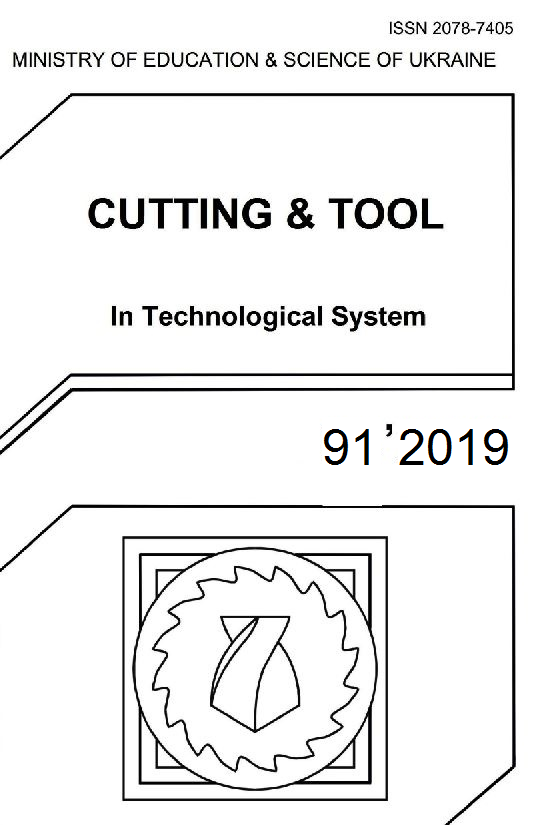EXAMINATION OF THE CHANGE IN SURFACE ROUGHNESS OF BURNISHED LOW ALLOYED ALUMINIUM EXTERNAL CYLINDRICAL PIECES
DOI:
https://doi.org/10.20998/2078-7405.2019.91.19Keywords:
surface roughness, polishing options, 3D roughness of the surface, polishing power.Abstract
The life and reliability of machine components or elements are affected greatly by the surface integrity. Machined surfaces by conventional processes such as turning and milling have inherent irregularities and defects like tool marks and scratches that cause energy dissipation (friction) and surface damage (wear). Ball burnishing has proved to be a highly effective mechanical finishing process of industrial workpieces because of the excellent surface roughness and fatigue performance that induces in treated components. This paper focuses on the examination of the influence of different burnishing parameters, such as number of passes (i), feed rate (f) and burnishing force (F). For plan and execute the experiments we use full factorial experimental design method by which empirical formulas can be created easily. The measurement of the surface roughness was executed with Altisurf 520 3D measuring equipment at the Institute of Manufacturing Science. The measured results were evaluated by the comparison of a special correlation formula to determine the optimal combination level of the different parameters in the given interval.References
J. Kundrak: Alternative machining procedures of hardened steels, Manufacturing Technology, 11, (2011) 32-39.
M. Horvath, J. Kundrak, A. G. Mamalis, K. Gyani: On the precision grinding of advanced ceramics, International Journal of Advanced Manufacturing Technology, 20 (4), (2002) 255-258.
J. Kundrak, K. Gyani, V. Bana: 3D roughness parameters of surface face milled by special tools, International Journal of Advanced Manufacturing Technology, 38 (1-2), (2008) 110-119.
J. Kundrak, C. Felho: 3D parameters of surface face milled by special tools, Manufacturing Technology, 16 (3), (2016) 532-538
C. Felho, J. Kundrak: Comparison of theoretical and real surface roughness in face milling with octagonal and circular inserts, Key Engineering Materials, 581, (2014) 360-365.
A. P. Borkar, P. S. Kamble, C. Y. Seemikeri: Surface Integrity Enhancement of Inconel 718 by using Roller Burnishing process, Int. J. of Current Engineering and Technology, 4 (4), (2014) 2595-2598.
G. Gomez-Gras, J. A. Travieso-Rodriguez, R. Jerez-Mesa: Experimental characterization of the influence of lateral pass width on results of a ball burnishing operation, Procedia Engineering, 132, (2015) 686-692.
A. M. Hassan: The effects of ball- and roller-burnishing on the surface roughness and hardness of some non-ferrous materials, Materials Processing Technology, 72, (1997) 385-391.
N. H. Loh: Effects of ball burnishing parameters on surface finish, Journal of Precision Engineering, 10, (1998), 215-220.
L. Fridrik: Chosen chapters from the topics of experimental design of production engineering, Műszaki Könyvkiadó, Budapest, 1987 (In Hungarian).
L. Bálint, L. Gribovszki (1975). The basics of machine engineering technology, Miskolc, pp: 418-442. (in Hungarian).
M. Posdzich, R. Stöckmann, F. Morczinek, M. Putz: Investigation of a plain ball burnishing process on differently machined Aluminium EN 2007 surfaces, MATEC Web of Conferences, 190, 11005, (2018) p. 7.
Downloads
Published
Issue
Section
License
Copyright Notice
Authors who publish with this Collection agree to the following terms:
1. Authors retain copyright and grant the Collection right of first publication with the work simultaneously licensed under a Creative Commons Attribution License that allows others to share the work with an acknowledgement of the work's authorship and initial publication in this Collection.
2. Authors are able to enter into separate, additional contractual arrangements for the non-exclusive distribution of the Collection's published version of the work (e.g., post it to an institutional repository or publish it in a book), with an acknowledgement of its initial publication in this Collection.
3. Authors are permitted and encouraged to post their work online (e.g., in institutional repositories or on their website) prior to and during the submission process, as it can lead to productive exchanges, as well as earlier and greater citation of published work.

